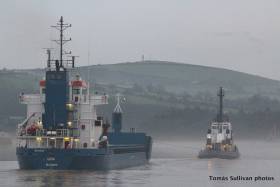Displaying items by tag: New Arklow cargsohip
Brand New Cargoship Calls In Wake of Older Cargoship Grounding
#Cargoships - One of Arklow Shipping’s newest cargoships, the single-hold Arklow Cape is today docked on the River Suir at Belview the Port of Waterford, writes Jehan Ashmore.
The Irish flagged 5,053dwt newbuild with Arklow as a port of registry, was launched in October last year and delivered into service the following month. The ‘C’’ class vessel is the second of a 10-ship order from Ferus Smit’s Dutch yard in Westerbroek.
Arklow Cape departed from Bayonne on the French Atlantic coast and the voyage took two days to reach Waterford Estuary. The newbuild arrived yesterday evening to Belview Terminal, downriver of Waterford City.
In the career of Arklow Cape typical cargoes will include grain to be carried in a ship that measures 87m in length overall and is a similar size to cargoship Lisa. The 89m vessel dating to 2001, however while on the neighbouring River Barrow more than a week ago got into difficulties having grounded.
Fortunately all crew were safe following the incident which saw the cargoship become stuck on a mud-bank south of the Pink Rock. The location is between the disused Barrow Railway Bridge and New Ross Port, the ship's destination.
Tugs were dispatched to the scene from Waterford based operator, Fastnet Shipping. Among the tugs involved was the 25 ton bollard pull tug Bargarth which came to the aid of the St. John's registered cargoship.
The undamaged Lisa was refloated and was able to continue the short leg upriver to the inland port to discharge a 4,500 tonne dry cargo.
After an inspection by maritime authorities, the cargoship was permitted to set sail.






























































